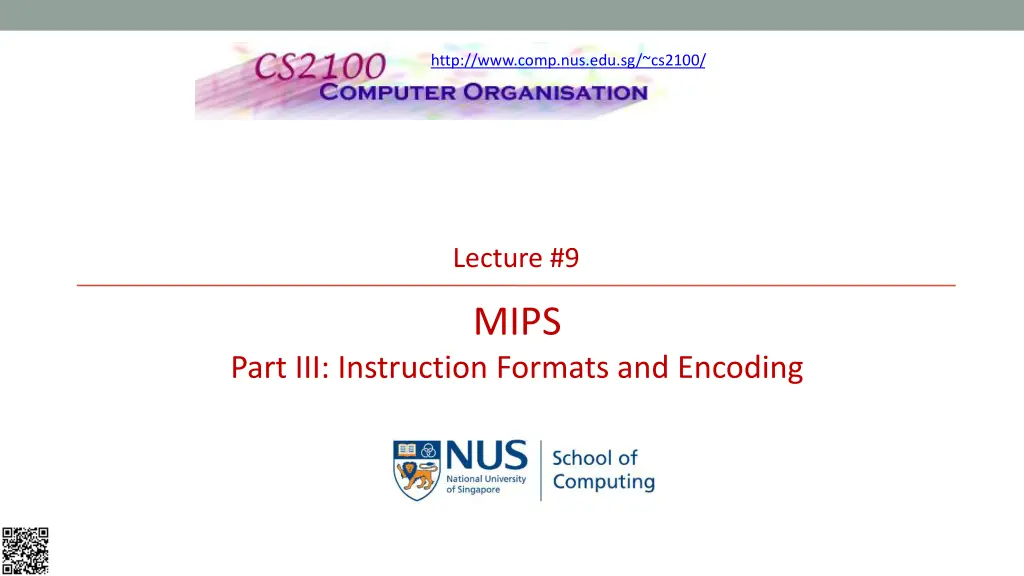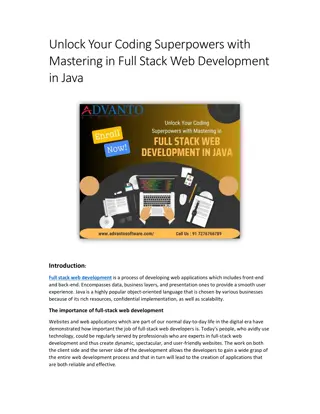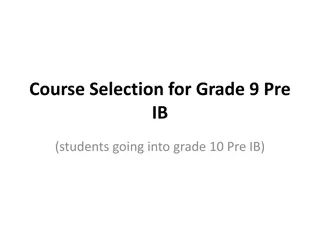
Understanding MIPS Instruction Formats and Encoding
Explore the intricacies of MIPS instruction formats and encoding with NUS Lecture #9. Learn about R-Format, I-Format, J-Format, and more to gain insights into building a MIPS processor. Unravel the mysteries behind immediate values and shift amounts in assembly code translation. Get ready to delve deeper into the world of MIPS processors!
Download Presentation

Please find below an Image/Link to download the presentation.
The content on the website is provided AS IS for your information and personal use only. It may not be sold, licensed, or shared on other websites without obtaining consent from the author. If you encounter any issues during the download, it is possible that the publisher has removed the file from their server.
You are allowed to download the files provided on this website for personal or commercial use, subject to the condition that they are used lawfully. All files are the property of their respective owners.
The content on the website is provided AS IS for your information and personal use only. It may not be sold, licensed, or shared on other websites without obtaining consent from the author.
E N D
Presentation Transcript
http://www.comp.nus.edu.sg/~cs2100/ Lecture #9 MIPS Part III: Instruction Formats and Encoding
Questions? Ask at https://sets.netlify.app/module/676ca3a07d7f5ffc1741dc65 OR Scan and ask your questions here! (May be obscured in some slides)
Aaron Tan, NUS Lecture #9: MIPS Part 3: Instruction Formats 3 Lecture #9: MIPS Part 3: Instruction Formats 1. Overview and Motivation 2. MIPS Encoding: Basics 3. MIPS Instruction Classification 4. MIPS Registers (Recap) 5. R-Format 5.1 R-Format: Example 5.2 Try It Yourself #1
Aaron Tan, NUS Lecture #9: MIPS Part 3: Instruction Formats 4 Lecture #9: MIPS Part 3: Instruction Formats 6. I-Format 6.1 I-Format: Example 6.2 Try It Yourself #2 6.3 Instruction Address: Overview 6.4 Branch: PC-Relative Addressing 6.5 Branch: Example 6.6 Try It Yourself #3 7. J-Format 7.1 J-Format: Example9 7.2 Branching Far Away: Challenge 8. Addressing Modes
Aaron Tan, NUS Lecture #9: MIPS Part 3: Instruction Formats 5 1. Overview and Motivation Recap: Assembly instructions will be translated to machine code for actual execution This section shows how to translate MIPS assembly code into binary patterns Explains some of the strange facts from earlier: Why is immediate limited to 16 bits? Why is shift amount only 5 bits? etc. Prepare us to build a MIPS processor in later lectures!
Aaron Tan, NUS Lecture #9: MIPS Part 3: Instruction Formats 6 2. MIPS Encoding: Basics Each MIPS instruction has a fixed-length of 32 bits All relevant information for an operation must be encoded with these bits! Additional challenge: To reduce the complexity of processor design, the instruction encodings should be as regular as possible Small number of formats, i.e. as few variations as possible
Aaron Tan, NUS Lecture #9: MIPS Part 3: Instruction Formats 7 3. MIPS Instruction Classification Instructions are classified according to their operands: Instructions with same operand types have same encoding R-format (Register format: op $r1, $r2, $r3) Instructions which use 2 source registers and 1 destination register e.g. add, sub, and, or, nor, slt, etc Special cases: srl, sll, etc. I-format (Immediate format: op $r1, $r2, Immd) Instructions which use 1 source register, 1 immediate value and 1 destination register e.g. addi, andi, ori, slti, lw, sw, beq, bne, etc. J-format (Jump format: op Immd) j instruction uses only one immediate value
Aaron Tan, NUS Lecture #9: MIPS Part 3: Instruction Formats 8 4. MIPS Registers (Recap) For simplicity, register numbers ($0, $1, , $31) will be used in examples here instead of register names Name Register number Usage Name Register number Usage $zero 0 Constant value 0 $t8-$t9 24-25 More temporaries $v0-$v1 2-3 Values for results and expression evaluation $gp 28 Global pointer $sp 29 Stack pointer $a0-$a3 4-7 Arguments $fp 30 Frame pointer $t0-$t7 8-15 Temporaries $ra 31 Return address $s0-$s7 16-23 Program variables $at (register 1) is reserved for the assembler. $k0-$k1 (registers 26-27) are reserved for the operation system.
Aaron Tan, NUS Lecture #9: MIPS Part 3: Instruction Formats 9 5. R-Format (1/2) Define fields with the following number of bits each: 6 + 5 + 5 + 5 + 5 + 6 = 32 bits 6 5 5 5 5 6 Each field has a name: opcode rs rt rd shamt funct Each field is an independent 5- or 6-bit unsigned integer A 5-bit field can represent any number 0 31 A 6-bit field can represent any number 0 63 NOTE: There are only 32 registers, so 5 bits for each register is enough. Similarly, it is enough for shamt field since shifting 32 bits clears the entire register.
Aaron Tan, NUS Lecture #9: MIPS Part 3: Instruction Formats 10 5. R-Format (2/2) Fields Meaning opcode - Partially specifies the instruction - Equal to 0 for all R-Format instructions - Combined with opcode exactly specifies the instruction - Specify register containing first operand funct rs(Source Register) - Specify register containing second operand rt(Target Register) rd(Destination Register) - Specify register which will receive result of computation - Amount a shift instruction will shift by - 5 bits (i.e. 0 to 31) - Set to 0 in all non-shift instructions shamt
Aaron Tan, NUS Lecture #9: MIPS Part 3: Instruction Formats 11 5.1 R-Format: Example (1/3) NOTE: Find the value of opcode and funct from the MIPS green sheet that contains all information. MIPS instruction add $8, $9, $10 R-Format Fields opcode funct rd rs rt shamt Value Remarks (textbook pg 94 - 101) (textbook pg 94 - 101) (destination register) (first operand) (second operand) (not a shift instruction) 0 32 8 9 10 0
Aaron Tan, NUS Lecture #9: MIPS Part 3: Instruction Formats 12 5.1 R-Format: Example (2/3) MIPS instruction Note the ordering of the 3 registers add $8, $9, $10 Field representation in decimal: opcode rs rt rd shamt funct 0 9 10 8 0 32 Field representation in binary: 000000 01001 01010 01000 00000 100000 Split into 4-bit groups for hexadecimal conversion: 0000 0001 0010 1010 0100 0000 0010 0000 016 116 216 A16 416 016 216 016
Aaron Tan, NUS Lecture #9: MIPS Part 3: Instruction Formats 13 5.1 R-Format: Example (3/3) MIPS instruction Note the placement of the source register sll $8, $9, 4 Field representation in decimal: opcode rs rt rd shamt funct 0 0 9 8 4 0 Field representation in binary: 000000 00000 01001 01000 00100 000000 Split into 4-bit groups for hexadecimal conversion: 0000 0000 0000 1001 0100 0001 0000 0000 016 016 016 916 416 116 016 016
Aaron Tan, NUS Lecture #9: MIPS Part 3: Instruction Formats 14 5.2 Try It Yourself #1 MIPS instruction add $10, $7, $5 Field representation in decimal: opcode rs 0 7 rt 5 rd 10 shamt 0 funct 32 Field representation in binary: 000000 00111 00101 01010 00000 100000 Hexadecimal representation of instruction: 0 0 E 5 5 0 2 016
Aaron Tan, NUS Lecture #9: MIPS Part 3: Instruction Formats 15 5. R-Format: Summary NOTE: opcode is always 0 shamt is always 0 arith is arithmetic operation MIPS instruction arith $rd, $rs, $rt opcode rs rt rd shamt funct 0 rs rt rd 0 XX NOTE: opcode is always 0 rs is always 0 shift is shift operation MIPS instruction shift $rd, $rt, shamt opcode rs rt rd shamt funct 0 0 rt rd shamt XX
Aaron Tan, NUS Lecture #9: MIPS Part 3: Instruction Formats 16 6. I-format (1/4) What about instructions with immediate values? 5-bit shamt field can only represent 0 to 31 Immediates may be much larger than this e.g. lw, sw instructions require bigger offset Compromise: Define a new instruction format partially consistent with R-format: If instruction has immediate, then it uses at most 2 registers NOTE: The reason why we want to keep some fields in the same position (e.g., opcode) is that by looking at the binary, we can quickly identify the instruction format. Also, we ensure that retrieving rs and rt will be consistent across R-format and I-format.
Aaron Tan, NUS Lecture #9: MIPS Part 3: Instruction Formats 17 6. I-format (2/4) Define fields with the following number of bits each: 6 + 5 + 5 + 16 = 32 bits 6 5 5 16 Again, each field has a name: opcode rs rt immediate Only one field is inconsistent with R-format. opcode, rs, and rt are still in the same locations. NOTE: We merge rd, shamt and funct to form a 16-bit field used for a constant value (immediate). That is, 5 + 5 + 6 = 16 bits. Just nice!
Aaron Tan, NUS Lecture #9: MIPS Part 3: Instruction Formats 18 6. I-format (3/4) opcode Since there is no funct field, opcode uniquely specifies an instruction rs specifies the source register operand (if any) rt specifies register to receive result note the difference from R-format instructions Continue on next slide
Aaron Tan, NUS Lecture #9: MIPS Part 3: Instruction Formats 19 6. I-format (4/4) immediate: Treated as a signed integer Except for bitwise operations (andi,ori,xori) 16 bits can be used to represent a constant up to 216 different values Large enough to handle: The offset in a typical lw or sw Most of the values used in the addi,slti instructions NOTE: This should answer why we cannot put 32-bit constants in the instruction. Because the instruction itself is only 32-bit wide. So we can only use parts of it. Plus, we still need to encode opcode, rs and rt.
Aaron Tan, NUS Lecture #9: MIPS Part 3: Instruction Formats 20 6.1 I-format: Example (1/2) MIPS instruction addi $21, $22, -50 I-Format Fields opcode rs rt immediate Value Remarks (textbook pg 94 - 101) (the only source register) (target register) (in base 10) 8 22 21 -50
Aaron Tan, NUS Lecture #9: MIPS Part 3: Instruction Formats 21 6.1 I-format: Example (2/2) MIPS instruction addi $21, $22, -50 Field representation in decimal: 8 22 21 -50 Field representation in binary: 001000 10110 10101 1111111111001110 Hexadecimal representation of instruction: 2 2 D 5 F F C E16
Aaron Tan, NUS Lecture #9: MIPS Part 3: Instruction Formats 22 6.2 Try It Yourself #2 MIPS instruction lw $9, 12($8) Field representation in decimal: opcode rs 35 8 rt 9 immediate 12 Field representation in binary: 100011 01000 01001 0000000000001100 Hexadecimal representation of instruction: 8 D 0 9 0 0 0 C16
Aaron Tan, NUS Lecture #9: MIPS Part 3: Instruction Formats 23 6.3 Instruction Address: Overview As instructions are stored in memory, they too have addresses Control flow instructions uses these addresses E.g. beq, bne, j As instructions are 32-bit long, instruction addresses are word-aligned as well Program Counter(PC) A special register that keeps address of instruction being executed in the processor
Aaron Tan, NUS Lecture #9: MIPS Part 3: Instruction Formats 24 6.4 Branch: PC-Relative Addressing (1/5) Use I-Format opcode rs rt immediate opcode specifies beq, bne rs and rt specify registers to compare What can immediate specify? Immediate is only 16 bits Memory address is 32 bits immediate is not enough to specify the entire target address!
Aaron Tan, NUS Lecture #9: MIPS Part 3: Instruction Formats 25 6.4 Branch: PC-Relative Addressing (2/5) How do we usually use branches? Answer: if-else, while, for Loops are generally small: Typically up to 50 instructions Unconditional jumps are done using jump instructions (j), not the branches Conclusion: A branch often changes PC by a small amount PC beq $9, $8, End End End:
Aaron Tan, NUS Lecture #9: MIPS Part 3: Instruction Formats 26 6.4 Branch: PC-Relative Addressing (3/5) Solution: Specify target address relative to the PC Target address is generated as: PC + the 16-bit immediatefield The immediatefield is a signed two s complement integer Can branch to 215 bytes from the PC: Should be enough to cover most loops End2 End2: - PC beq $9,$8,End + End End:
Aaron Tan, NUS Lecture #9: MIPS Part 3: Instruction Formats 27 6.4 Branch: PC-Relative Addressing (4/5) Can the branch target range be enlarged? Observation: Instructions are word-aligned Number of bytes to add to the PC will always be a multiple of 4. Interpret the immediate as number of words, i.e. automatically multiplied by 410 (1002) Can branch to 215words from the PC i.e. 217 bytes from the PC We can now branch 4 times farther!
Aaron Tan, NUS Lecture #9: MIPS Part 3: Instruction Formats 28 6.4 Branch: PC-Relative Addressing (5/5) Branch calculation: If the branch is not taken: PC = PC + 4 (PC + 4 is address of next instruction) If the branch is taken: PC = (PC + 4) + (immediate 4) Observations: immediatefield specifies the number of words to jump, which is the same as the number of instructions to skip over immediate field can be positive or negative Due to hardware design, add immediate to (PC+4), not to PC (more in later topic)
Aaron Tan, NUS Lecture #9: MIPS Part 3: Instruction Formats 29 6.5 Branch: Example (1/3) Loop: beq $9, $0, End # rlt addr: 0 add $8, $8, $10 # rlt addr: 4 addi $9, $9, -1 # rlt addr: 8 j Loop End: # rlt addr: 16 # rlt addr: 12 beq is an I-Format instruction I-Format Fields opcode rs rt immediate Value Remarks 4 9 0 (first operand) (second operand) (in base 10) ???
Aaron Tan, NUS Lecture #9: MIPS Part 3: Instruction Formats 30 6.5 Branch: Example (2/3) Loop: beq $9, $0, End # rlt addr: 0 add $8, $8, $10 # rlt addr: 4 addi $9, $9, -1 # rlt addr: 8 j Loop End: # rlt addr: 16 # rlt addr: 12 immediate field: Number of instructions to add to (or subtract from) the PC, starting at the instruction following the branch In beq case, immediate = 3 End = (PC + 4) + (immediate 4)
Aaron Tan, NUS Lecture #9: MIPS Part 3: Instruction Formats 31 6.5 Branch: Example (3/3) Loop: beq $9, $0, End # rlt addr: 0 add $8, $8, $10 # rlt addr: 4 addi $9, $9, -1 # rlt addr: 8 j Loop End: # rlt addr: 16 # rlt addr: 12 Field representation in decimal: opcode rs 4 9 rt 0 immediate 3 Field representation in binary: 000100 01001 00000 0000000000000011
Aaron Tan, NUS Lecture #9: MIPS Part 3: Instruction Formats 32 6.6 Try It Yourself #3 Loop: beq $9, $0, End # rlt addr: 0 add $8, $8, $10 # rlt addr: 4 addi $9, $9, -1 # rlt addr: 8 beq $0, $0, Loop # rlt addr: 12 End: # rlt addr: 16 What would be the immediate value for the second beq instruction? Answer: 4
Aaron Tan, NUS Lecture #9: MIPS Part 3: Instruction Formats 33 6. I-Format: Summary NOTE: C162s is in 2s complement arith is arithmetic operation MIPS instruction arith $rt, $rs, C162s opcode rs rt immediate XX rs rt C162s NOTE: C162s is in 2s complement ld/st is a load or store operation MIPS instruction ld/st $rt, C162s($rs) opcode rs rt immediate XX rs rt C162s
Aaron Tan, NUS Lecture #9: MIPS Part 3: Instruction Formats 34 6. I-Format: Summary NOTE: C16 is raw binary (no negative) logic is logical operation (bitwise operation) MIPS instruction logic $rt, $rs, C16 opcode rs rt immediate XX rs rt C16 NOTE: branch is a branch operation label is converted to number first (PC-relative addressing) MIPS instruction branch $rs, $rt, label opcode rs rt immediate XX rs rt label NOTE: please note the position of rs and rt here. The first register is NOT rt but is rs instead!
Aaron Tan, NUS Lecture #9: MIPS Part 3: Instruction Formats 35 7. J-Format (1/5) For branches, PC-relative addressing was used: Because we do not need to branch too far For general jumps (j): We may jump to anywhere in memory! The ideal case is to specify a 32-bit memory address to jump to Unfortunately, we can t ( why?)
Aaron Tan, NUS Lecture #9: MIPS Part 3: Instruction Formats 36 7. J-Format (2/5) Define fields of the following number of bits each: 6 bits 26 bits As usual, each field has a name: opcode target address Keep opcode field identical to R-format and I-format for consistency Combine all other fields to make room for larger target address
Aaron Tan, NUS Lecture #9: MIPS Part 3: Instruction Formats 37 7. J-Format (3/5) We can only specify 26 bits of 32-bit address Optimisation: Just like with branches, jumps will only jump to word- aligned addresses, so last 2 bits are always 00 So, let s assume the address ends with 00 and leave them out Now we can specify 28 bits of 32-bit address
Aaron Tan, NUS Lecture #9: MIPS Part 3: Instruction Formats 38 7. J-Format (4/5) Where do we get the other 4 bits? MIPS choose to take the 4 most significant bits from PC+4 (the next instruction after the jump instruction) This means that we cannot jump to anywhere in memory, but it should be sufficient most of the time Question: What is the maximum jump range? 256MB boundary Special instruction if the program straddles 256MB boundary Look up jr instruction if you are interested Target address is specified through a register
Aaron Tan, NUS Lecture #9: MIPS Part 3: Instruction Formats 39 7. J-Format (5/5) Summary: Given a Jump instruction opcode 000010 00001111000011110000111100 target address 32bit PC 1010 The rest of the PC+4 is ignored! Jumps To 1010 00001111000011110000111100 00 Most Default 2bit "00" for word address 26bits Target address specified in instruction significant 4bits of PC+4
Aaron Tan, NUS Lecture #9: MIPS Part 3: Instruction Formats 40 7. 256MB Boundary Due to the use of the first 4-bits from the PC (i.e., the memory address of the currently executed instruction), we can only jump within our block. If you are at the top of the boundary, jump up. If you are at the bottom of the boundary, you cannot jump down. Can you figure out the address of the top and the bottom? (discuss in forum) 0x 0000 0000 256MB you cannot 0x 1000 0000 256MB 0x 2000 0000 256MB 0x 3000 0000 256MB
Aaron Tan, NUS Lecture #9: MIPS Part 3: Instruction Formats 41 7.1 J-Format: Example Loop: beq $9, $0, End # addr: 8 add $8, $8, $10 # addr: 12 addi $9, $9, -1 # addr: 16 j Loop # addr: 20 End: # addr: 24 jump target PC PC 0000 ..10100 Check your understanding by constructing the new PC value Address to jump to 0000 ..01000 immediate =2 (26 bits) opcode 000010 target address 00000000000000000000000010
Aaron Tan, NUS Lecture #9: MIPS Part 3: Instruction Formats 42 7.2 Branching Far Way Given the instruction Assume that the address L1 is farther away from the PC than what can be supported by beq and bne instructions beq $s0, $s1, L1 Challenge: Construct an equivalent code sequence with the help of unconditional (j) and conditional branch (beq, bne) instructions to accomplish this far away branching NOTE: Discuss in forum
Aaron Tan, NUS Lecture #9: MIPS Part 3: Instruction Formats 43 8. Addressing Modes (1/3) Register addressing: operand is a register op rs rt rd funct Register MIPS: add, sub, and, or, xor, nor, slt, sll, srl Immediate addressing: operand is a constant within the instruction itself (addi, andi, ori, slti) op rs rt immediate MIPS: addi, andi, ori, xori, slti
Aaron Tan, NUS Lecture #9: MIPS Part 3: Instruction Formats 44 8. Addressing Modes (2/3) Base addressing (displacement addressing): operand is at the memory location whose address is sum of a register and a constant in the instruction (lw, sw) Memory op rs rt Address MIPS: lw, sw + Register word
Aaron Tan, NUS Lecture #9: MIPS Part 3: Instruction Formats 45 8. Addressing Modes (3/3) PC-relative addressing: address is sum of PC and constant in the instruction (beq, bne) Memory op rs rt Address MIPS: beq, bne + PC word Pseudo-direct addressing: 26-bit of instruction concatenated with upper 4-bits of PC (j) Memory op Address MIPS: j : PC word
Aaron Tan, NUS Lecture #9: MIPS Part 3: Instruction Formats 46 Summary (1/2) MIPS Instruction: 32 bits representing a single instruction opcode rs R rt rd shamt funct opcode opcode rs rt immediate I target address J Branches and load/store are both I-format instructions; but branches use PC-relative addressing, whereas load/store use base addressing Branches use PC-relative addressing Jumps use pseudo-direct addressing Shifts use R-format, but other immediate instructions (addi, andi, ori) use I-format IN OTHER WORDS: beq, bne: ignore PC, count displacement j: use PC, displacement ignore
Aaron Tan, NUS Lecture #9: MIPS Part 3: Instruction Formats 47 Summary (2/2) MIPS assembly language Example add $s1, $s2, $s3 Category Instruction Meaning Comments add Three operands; data in registers $s1 = $s2 + $s3 subtract Three operands; data in registers Arithmetic sub $s1, $s2, $s3 $s1 = $s2 - $s3 add immediate load word store word Used to add constants addi $s1, $s2, 100 lw $s1, 100($s2) sw $s1, 100($s2) lb $s1, 100($s2) sb $s1, 100($s2) lui $s1, 100 $s1 = $s2 + 100 $s1 = Memory[$s2 + 100]Word from memory to register Memory[$s2 + 100] = $s1 Word from register to memory $s1 = Memory[$s2 + 100]Byte from memory to register Memory[$s2 + 100] = $s1 Byte from register to memory $s1 = 100 * 216 Data transfer load byte store byte load upper immediate Loads constant in upper 16 bits branch on equal if ($s1 == $s2) go to PC + 4 + 100 Equal test; PC-relative branch beq $s1, $s2, 25 branch on not equal bne $s1, $s2, 25 if ($s1 != $s2) go to PC + 4 + 100 Not equal test; PC-relative Conditional branch set on less than if ($s2 < $s3) $s1 = 1; else $s1 = 0 Compare less than; for beq, bne slt $s1, $s2, $s3 set less than immediate slti $s1, $s2, 100 if ($s2 < 100) $s1 = 1; else $s1 = 0 Compare less than constant go to 10000 go to $ra $ra = PC + 4; go to 10000 For procedure call jump jump register jump and link Jump to target address For switch, procedure return j 2500 jr $ra jal 2500 Uncondi- tional jump
Aaron Tan, NUS Lecture #9: MIPS Part 3: Instruction Formats 48 End of File






















